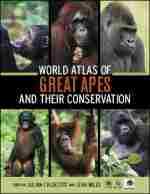
|
| Home | Milieu & Energie | Gezondheid & Wetenschap | Duurzaam Bouwen | Photo Gallery |
| Geologie & Reizen | Landbouw & Voeding | Natuurbescherming | Eilanden | Geokids |
|
Recently, the impressive first World Atlas of Great Apes and their Conservation was released in which the state of the art of the great apes is described in detail. |

|
|
Met zijn boek De aap in ons (Our Inner Ape) laat primatoloog Frans de Waal ons 264 pagina's lang spiegelen aan de twee
mensapensoorten die genetisch het dichtst bij ons staan: de bonobo en de chimpansee. Onze gemeenschappelijke stamboom gaat 5,5 miljoen jaar terug.
'We zijn gezegend met twee naaste verwanten onder de primaten die we kunnen bestuderen en die als dag en nacht van elkaar verschillen,'
schrijft De Waal. De mens combineert de twee uiteenlopende karakters van de norse, ambitieuze chimpansee en de vrijmoedige, zorgeloze bonobo. |
|
A shame for the human race. Not only do we kill are fellow humans, there's a real chance that the Great Apes get extinct during our lifetime.
Decline of natural habitat is not the only cause for the alarming decline. Especially in Congo, every year chimps, bonobo's and gorilla's
are eaten as bushmeat. Due to more intense infrastructure in the rainforest, the great ape's habitat becomes accessible. Of all great
apes, chimps and bonobo's are our closest relatives. Jane Goodall, a leading primatologist
specialised in chimpansees, says local African economies should be strengthened to prevent the trade in bushmeat. |

